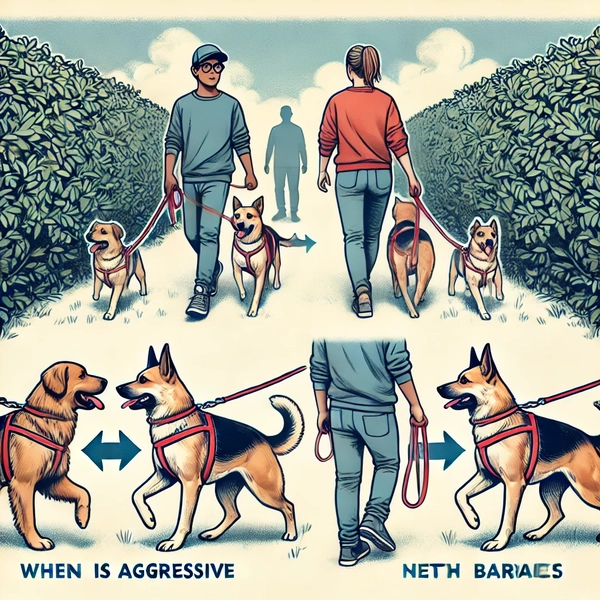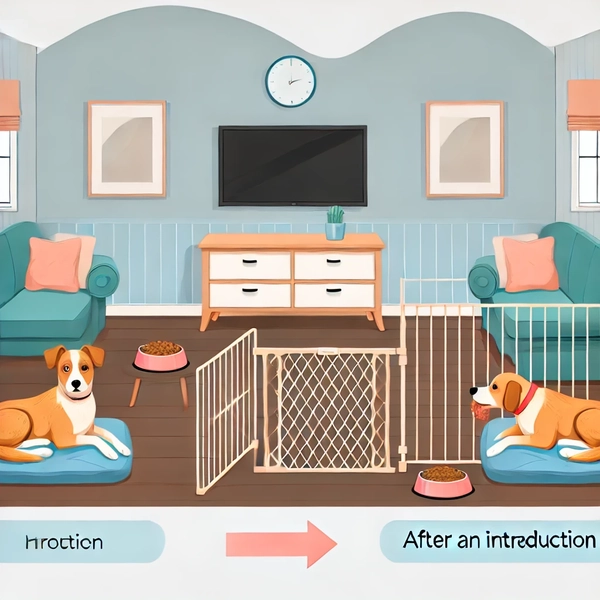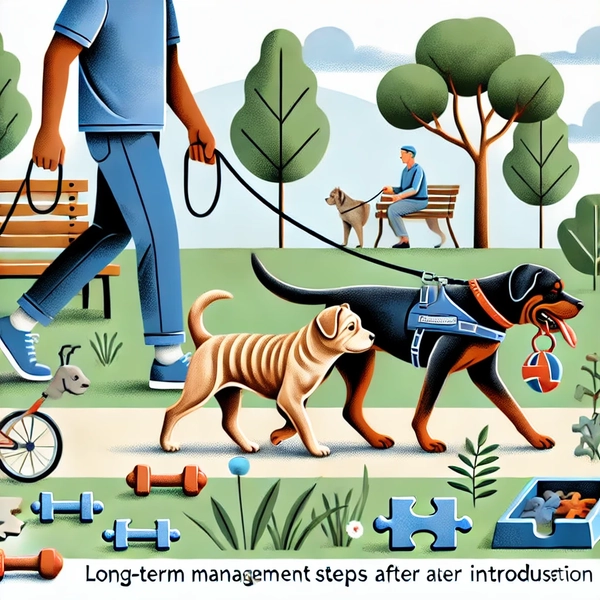How to introduce dogs when one is aggressive? Introducing a new dog to an aggressive one may seem daunting, but it can be accomplished correctly. It takes patience, preparation, and a tranquil environment.
This article will guide you on the causes of dog aggression, how to prepare the dogs and yourself for an introduction, how to control behavior and finally, how to keep the peace.
Understanding Dog Aggression
The first rule in integrating dogs is knowing why your dog is aggressive. Aggression can be:
- Cautiousness: Some dogs don’t like new things or even other animals, and thus they are defensive.
- Protectiveness: Dogs can also be protective of their space and things, such as toys or ‘people,’ which may cause them to act aggressively.
- Lack of Exposure: Some dogs have never encountered other dogs or other social situations and may find it hard to meet new dogs.
Types of Aggression

- Fear-based Aggression: These dogs bark, growl, or lunge when they see something triggering them. Such dogs have to be given more time to acclimatize.
- Territorial Aggression: This is another aggressive complementary type of defense typical for certain dogs. Such dogs must feel that their territory is protected from invasions or intruders.
- Possessive Aggression: A dog that possesses something, be it a food bowl, toys, or a person, will likely lose control when an unfamiliar dog intrudes on these ‘possessions.’
Knowing the causes assists in developing an effective introduction procedure and predicting potential responses.
Preparing for the Introduction
Before bringing the dogs together, set the stage for success:
- Create a Neutral Environment: Dogs are less territorial in places they don’t associate with their space. Parks, quiet streets, or open fields are excellent first-meeting locations.
- Plan for Parallel Walks: Walking both dogs side by side, but at a distance, is a safe way to begin. This method helps them get used to each other’s presence without direct contact.
- Use Proper Equipment:
- Leashes and Harnesses: opt for comfortable harnesses instead of choke collars to avoid stress.
- Treats: Keep high-value treats handy to reward calm behavior and encourage positive interactions.
Checklist for Preparation
| Preparation Step | Why It Matters |
| Neutral location | Reduces territorial behavior |
| Comfortable equipment | Keeps dogs calm and under control |
| High-value treats | Reinforces positive behavior |
How to Introduce Dogs When One Is Aggressive

Step-by-step guide for introducing the dogs
Step 1: Parallel Walking
Parallel walking allows both dogs to get accustomed to each other’s presence without confrontation. Here’s how:
- Keep Distance: Start with each dog on opposite sides of a wide path. This allows them to see and smell each other but keeps enough space to avoid triggering aggression.
- Reward Calm Behavior: Whenever either dog looks at the other calmly or shows curiosity, reward them with treats. This links positive behavior with the presence of the other dog.
- Use Natural Barriers: If one dog starts showing signs of distress (barking, lunging), use barriers like trees or cars to block their view and calm them down.
Step 2: Gradual Reduction of Distance
As the dogs become more comfortable:
- Slowly Close the Gap: Reduce the distance between them gradually. Move to narrower paths or smaller parks where they can be closer but still have room to retreat if needed.
- Observe Body Language: Watch for signs like raised fur, stiff bodies, or intense staring. If either dog shows these signs, give them more space again.
Pro Tip: Maintain a loose leash. A tight leash can transmit tension and make the dogs feel trapped, increasing the likelihood of aggression.
Step 3: Controlled Interactions
Once both dogs show signs of comfort:
- Short Sniffing Sessions: Allow brief, supervised interactions where the dogs sniff each other. Keep the leashes loose and keep these encounters short.
- Reward Calm Interactions: Praise and treat both dogs when they approach each other calmly. This reinforces that positive behavior around the other dog is rewarding.
- Take Breaks: After a few seconds, call the dogs apart and let them reset. This prevents over-stimulation.
Management Tips at Home

Transitioning to home interactions requires continued management. Here are some strategies:
1. Separate Feeding and Resting Areas
- Feed in Different Rooms: To avoid food-related aggression, keep meals separate. You can divide spaces using baby gates or crates.
- Create Quiet Zones: Set up quiet, cozy spots where dogs can retreat when they need alone time. This reduces the chance of conflict when they need to rest or relax.
2. Monitor Play and Body Language
Even if the initial meetings go well, supervision is necessary:
- Watch for Signs of Stress: Dogs may stiffen up, avoid eye contact, or growl when they feel threatened. Intervene early if you see these signals.
- Control Play Sessions: Allow dogs to play, but keep sessions short and light. Avoid toys that may trigger resource-guarding behaviors.
3. Training and Positive Reinforcement
Training helps set boundaries and encourages positive behavior:
- Teach Basic Commands: Commands like “sit,” “stay,” and “leave it” help manage the dogs during interactions. Practice these regularly and reward them.
- Practice Hand Targets: Teaching dogs to target your hand helps you redirect their focus when they seem tense.
Achieving Long-Term Management Steps for Dogs

Most people believe that introducing dogs is a single venture, but a dog introduction requires constant management and adjustment. Here are steps that can be taken to ensure there is no disharmony in the long run:
1. Exercise and Mental Stimulation
- Daily Walks: Regular walks help burn excess energy and relieve stress. Over time, taking the dogs for a walk together strengthens the bond.
- Puzzle Toys: Toys that require dogs to think are essential in minimizing boredom, especially for active or aggressive dogs.
2. Desensitization and Counter-Conditioning
- Desensitization will be used to help the dog tolerate the gradual introduction of changes over the course of a few months.
- Gradually Increase Exposure: If your canine has overreactions to certain stimuli, such as close approaching dogs, an initial controlled and distant exposure should be given. While the animal exposes itself to approaching dogs, the distance can be shortened as it becomes tolerant.
- Reward Calm Behavior: Every time the trigger is present, encourage your dog to remain level-headed and reward him for obedience to build positive relations.
3. Hire The Professionals When Necessary
At times, no matter how much time is given to training, the aggression can be maintained. This is the point where assistance from the outside comes in handy:
Behavior is conducted outside the rehabilitation center, and strategies are given by the Certification of Dog Behavior Consultant (CDBC).
They aid you in safely performing such implementations as counter-conditioning and behavior modification.
Common Mistakes to Avoid
It’s easy to make mistakes when introducing an aggressive dog to a new companion. Here’s what to avoid:
| Mistake | Why It’s a Problem |
| Rushing the Process | Leads to stress and increases aggression |
| Ignoring Body Language | Misses early signs of discomfort |
| Using Punishment Techniques | Increases fear and aggression |
| Introducing Dogs at Home First | Increases territorial aggression risk |
| Tight Leashes During Meetings | Signals tension and makes dogs uneasy |
Last Suggestions for an Efficient Canine Introduction.
Introducing a dog exhibiting aggressive tendencies toward another dog takes consideration, time, and a positive outlook. Remember to follow these last suggestions for the best effect and results.
- Do Not Be Agitated. Dogs can clinch your energy. If you are relaxed, they are likely to be relaxed as well.
- Limit Sessions to a Certain Time: A series of brief and positive experiences is more effective than long and adverse experiences. As the two dogs get used to one another, the time should be increased.
- Correctly employ Treats: Notwithstanding high-value treats, all satisfaction claims are divisors of the aggression. Opt to use them to encourage calmness with the understanding that they cannot be used permanently. At this point, it will be understood that the treats will no longer be in use due to the behavior of the dogs exhibited.
- Be Adaptable: Every dog is different. What is effective for one dog may not be so for another. Thus, one should be ready to change his or her strategy depending on what they see working.
Conclusion
To sum up, Aggression in introducing a dog to another dog is done carefully and gradually. There is a cause for aggression, and understanding how aggression operates, there are measures such as cheerful walks and positive reinforcement that can protect both dogs.
Take your time, keep their movements in check, and celebrate even the small victories. And when these challenges arise, go further like a trainer to speed up your transition.